5 Snack Aisle Brands to Stay Away From Right Now

It’s been drilled into your head for as long as we can remember: Three meals per day! Breakfast, lunch, and dinner should be more than enough to get all the calories we need. So why does snacking between meals come so naturally to us?
In short, the “three meal per day” rule is a byproduct of civilization and society, not our bodies’ needs. Before Christopher Columbus brought all the wonders (and diseases) of Europe to the new world, Native Americans generally ate whenever they were hungry.
“The eating schedule of the native tribes was less rigid… the Europeans took this as ‘evidence that natives were uncivilized,'” Abigail Carroll, author of the book Three Squares: The Invention of the American Meal, told National Review. “Civilized people ate properly and portioned their eating, thus differentiating themselves from the animal kingdom, where grazing is the norm.”
Fast forward to today, and modern medicine has largely debunked the notion that three meals per day are ideal. According to Cornell University’s Health Department, it’s best to fuel your day with both meals and snacks. In other words, don’t go any longer than three to four hours at a time without eating.
For the most part, Americans don’t need any extra incentive to keep on snacking. One survey tells us that the average U.S. citizen will spend close to $30,000 on snacks over the course of their life! Meanwhile, a similar poll reports that close to half of Americans routinely hide treats throughout their home for covert snacking.
Eating between meals, in a vacuum, isn’t necessarily a negative. Snacking only becomes a real dietary problem if we choose to munch on the wrong food items. There’s certainly no shortage of options waiting for shoppers in the snack aisle, so which items should you avoid?
“Franken-snack foods as I like to call them, foods with no (or far off) expiration dates, no legible ingredients, and completely engineered,” explains Whitney Stuart, RDN.
Looking for more specific grocery list guidance? You’re in luck! We’ve put together a list of the worst snack aisle brands you should stay far, far away from.
And don’t miss 4 Meat Companies With the Worst Food Quality Practices.
Nutella
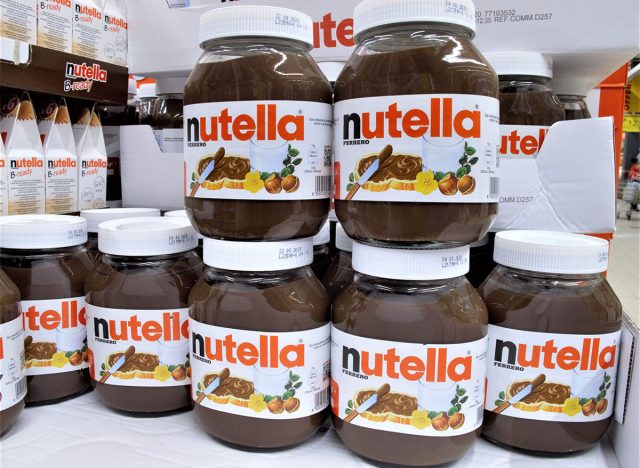
You’re probably already aware that Nutella isn’t the best choice if you’re looking for a healthy snack. A few years back, an image showing the ridiculous amounts of sugar present in a jar of Nutella went viral—and for good reason. The sugar levels in this hazelnut-chocolate spread are truly obscene. A single 13-ounce jar contains 210 grams of sugar.
What you may not know, however, is that once upon a time Nutella actually attempted to market itself as a “health food”—and ended up getting sued for it. This commercial portrays Nutella as a convenient, healthy option for busy families looking for a quick breakfast on hectic mornings. The ad talks up Nutella’s “simple, quality ingredients” like skim milk and a hint of cocoa, yet fails to mention anything about sugar.
The public felt so misled by this commercial that a class-action lawsuit was filed, and won, against Ferrero USA, Nutella’s manufacturer. At the time (2014), Nutella also promised to revise its advertising practices and provide better nutritional information on its labels.
But wait, there’s more: Another of Nutella’s main ingredients, palm oil, has been named as a likely carcinogen in recent years.
It’s also worth keeping this in mind: Ferrero uses roughly a full quarter of the world’s hazelnut supplies to produce Nutella, no doubt contributing mightily to worldwide hazelnut shortages.
Twinkies
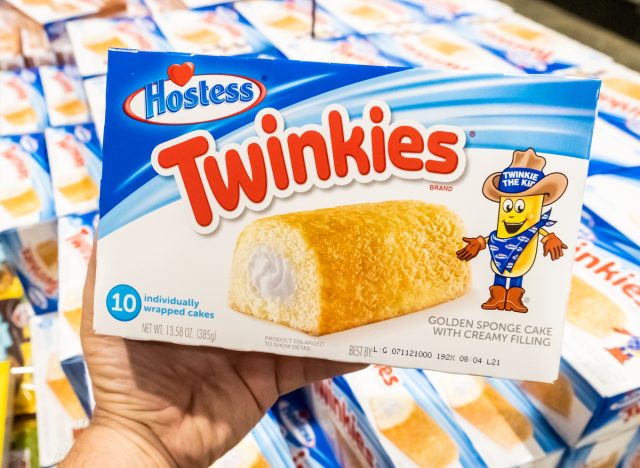
Twinkies have been an iconic American snack for nearly a century! Here’s a Twinkie fact, however, that may make you lose your appetite. When Twinkies were first invented way back in 1930, they had a very short shelf-life of only two days. Any longer, and ingredients like eggs, milk, and butter would sour.
Today’s Twinkies, however, boast an astounding shelf-life of 45 days. While having a month and a half to eat a box of Twinkies may be convenient, one can’t help but wonder what’s changed since 1930. In a few words: artificial ingredients, color dyes, and preservatives.
Besides tons of sugar, here are just a few of the ingredients you’re ingesting each time you chown down on a Twinkie: cellulose gum, polysorbate 60, hydrogenated oils, and the artificial colors yellow 5 and red 40.
Yellow 5 is linked to hyperactivity in children, while both red 40 and polysorbate 60 have shown carcinogenic tendencies.
It’s also worth mentioning that back in the 1990s a pair of college students decided to conduct a series of tests on Twinkies. Dubbed the T.W.I.N.K.I.E.S. Project, that research found Twinkies (at least back in 1995) are only flammable when doused in rubbing alcohol, resistant to falls from a sixth-story window, and even unaffected by 110 electrical volts. Not exactly all-natural.
Frito-Lay snacks
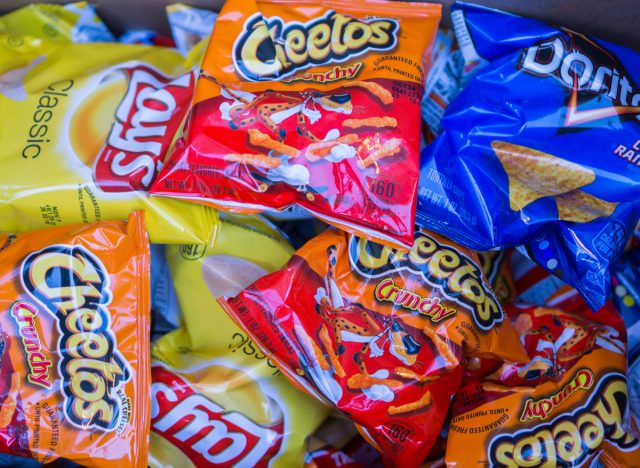
It doesn’t get much bigger than Frito-Lay. From Fritos and Cheetos to Doritos and classic Lays, The Frito-Lay brand is a snack powerhouse. Unfortunately, with great power also comes a whole lot of sketchy ingredients, apparently.
“Frito Lay is a top franken-snack offender, using inflammatory oils, like soybean oil, in a large majority of their foods,” Stuart says.
It’s true, numerous Frito-Lay products contain soybean oil. Already associated with obesity and diabetes, recent preliminary research published in the scientific journal Endocrinology also suggests soybean oil may actually spark genetic changes in the brain and influence neurological conditions ranging from anxiety and depression to dementia. Those findings are far from conclusive, but no less unappetizing.
Frito-Lay was recently in the news for another troubling issue: How the company treats its workers. The summer of 2021 saw hundreds of workers at a Kansas Frito-Lay factory go on strike for weeks over bad working conditions and ridiculously long hours.
More specifically, the picketing workers called for an end to their suicide shifts. Union leaders claimed many workers at the plant were being forced into working 84-hour weeks due to mandatory, forced overtime. One employee even claimed to have seen coworkers carried out of the factory on stretchers on more than one occasion.
Frito-Lay asserted that those claims were “grossly exaggerated,” but the strike dragged on until the workers were granted a 4% pay raise and at least one guaranteed day off per week.
Doritos
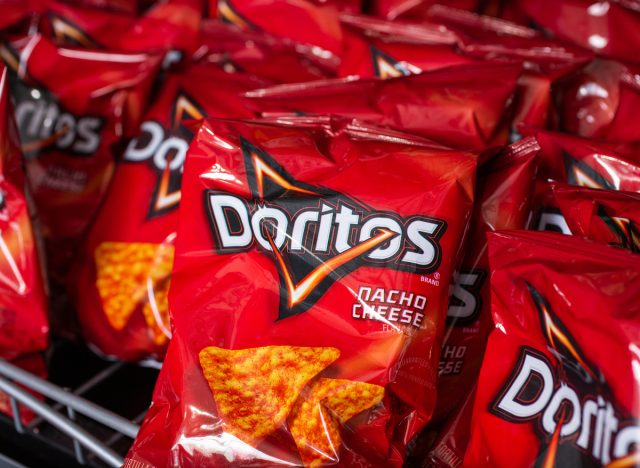
One of Frito-Lay’s biggest sub-brands is Doritos—and this chip deserves its own separate entry on this list.
It’s estimated that Doritos brings in an astounding $1.5 billion in annual U.S. sales for Frito-Lay. So why are these chips constantly flying off grocery shelves?
Experts believe Doritos are intentionally crafted to be as addictive as possible, enticing our taste buds just enough to keep us wanting more while never really satisfying our hunger. Even so, that’s far from the only reason to stay away from these chips.
“Doritos are not only made with nutritionally poor ingredients, but with concerning additives,” says nutritionist Lisa Richards, author of The Candida Diet. “They are fried in inflammatory omega-6 oils which are connected to cardiovascular disease, diabetes, obesity, and a wide variety of chronic conditions.”
“Doritos contain monosodium glutamate (MSG), a controversial additive placed in many snack foods to enhance flavor, shelf life, and taste in some cases. It is thought to be connected with concerning health outcomes and some individuals have an intolerance to MSG,” she adds.
Slim Jim
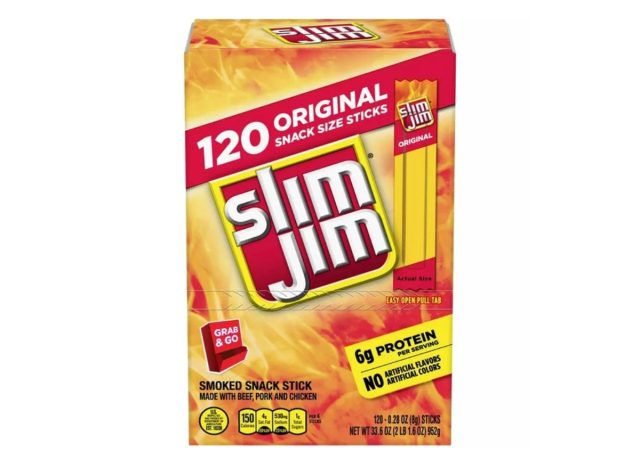
Known for their off-the-wall marketing campaigns, and distinct bright red and yellow packaging, Slim Jims are a snack staple at grocery stores and gas stations all over the country. Officially, the brand offers “meat sticks and jerky snacks,” but have you ever wondered what you’re actually eating when you snap into a Slim Jim?
Here are just a few of the ingredients: Beef, mechanically separated chicken (yum!), sodium nitrite, and hydrolyzed soy. While it’s tough to imagine a phrase more unappetizing than “mechanically separated chicken,” sodium nitrite is directly associated with colorectal cancer.
It’s encouraging that Slim Jims contain actual beef, but according to Wired, these meat sticks are made up of very low-quality beef from older cows. Slim Jims do boast the savory umami flavor that is synonymous with meat. But, it’s a pseudo-version of umami, produced by the hydrolyzed soy—not any of the added meats found in the final product.
Perhaps Is It Bad For You summed up this snack best: “If Slim Jims are all you have to eat and you are miles from civilization, eat one to stay alive. Otherwise, it should be avoided entirely.”









